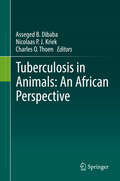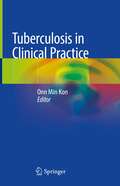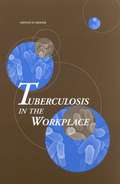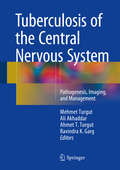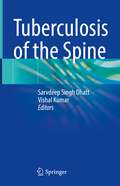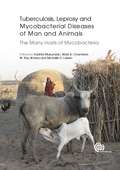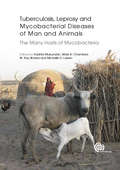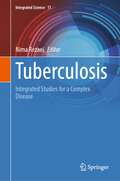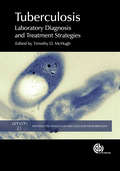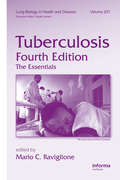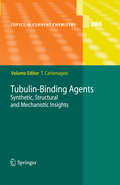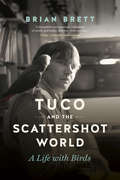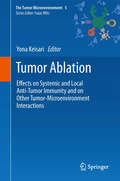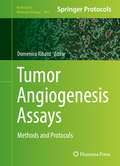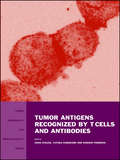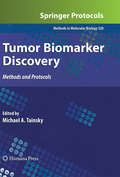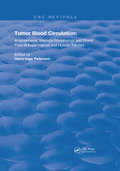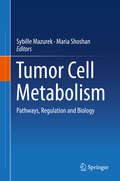- Table View
- List View
Tuberculosis in Animals: An African Perspective
by Charles O. Thoen Asseged B. Dibaba Nicolaas P. J. KriekThis book recounts the biology of M. bovis, followed by the status of bovine Tuberculosis (bTB) in African countries, primarily based on zoonotic and epidemiological field reports. Since the accumulation of data is valueless unless it led to practicable control measures, emphasis is put on locally adapted protocols for future control of the disease. In order to systematically evaluate the knowledge base of bTB, Epidemiologic Problem Oriented Approach (EPOA) methodology was used. The methodology is composed of two triads: i) the problem identification/characterization triad, which is mainly descriptive in nature, and ii) the problem management/solution/mitigation triad, which is mainly geared toward problem management/solution (see figure). The first triad comprises three pillars: i) agent ii) host, and iii) environment and the second one: i) therapeutics/treatment, ii) prevention/control, and iii) health maintenance/promotion. The two triads are linked together by the diagnostic procedure linkage. The systematic and detailed studies of the ‘Host-Agent-Environment’ interactions are the building blocks to the understanding of agent transmission pathways and disease spread. These may include data about the disease status of the country, the nature of the disease agent and its hosts, the modes of transmission, the wildlife reservoirs in nature, persistence of infection, and agent survival in animal products and the environment. The problem identification and characterization triad identifies these interactions. Once a problem has been identified and well understood, the next step is to minimize the risk of transmission and spread of a disease. This area, referred to as problem solution/management triad, consists of problem management alternatives that rely upon prevention/control, and health maintenance/promotion of the disease in livestock, wildlife, and humans with the emphasis on resource-poor, developing countries in Africa.
Tuberculosis in Clinical Practice
by Onn Min KonThis book is targeted at ensuring frontline clinical staff including seniors, trainees and specialist nurses can easily reference the optimum investigation and management of potential TB cases. This will mirror the annual London Advanced TB course which aims to equip all of the team delivering care to have a working knowledge of the entire spectrum of the real life aspects of TB management ranging from investigation of active TB to latent screening in pre biologic therapy. It includes an update of MDR TB management and also the approaches needed to ensure the entire medico-social spectrum of TB care is addressed.
Tuberculosis in the Workplace
by Institute of MedicineThis National Institute of Medicine committee report on the resurgence of tuberculosis in the US focuses on the risks of occupational exposure for health- care workers. It reviews responses to resurgent TB and proposed strategies for its elimination in the US and worldwide; provides an overview of TB transmission, infection, and disease; discusses established and proposed federal standards to protect workers from occupational exposure to TB; and considers the effects of existing guidelines for preventing TB exposure in health-care facilities as well as the likely effects of standards proposed by the Occupational Safety and Health Administration. Annotation c. Book News, Inc. , Portland, OR (booknews. com)
Tuberculosis of the Central Nervous System
by Mehmet Turgut Ali Akhaddar Ahmet T. Turgut Ravindra K. GargWritten and edited by leading international authorities in the field, this book provides an in-depth review of knowledge of tuberculosis of the central nervous system, with emphasis on clinical, diagnostics, and therapeutic features. Tuberculosis, one of the most lethal diseases in human history, still poses a serious threat in the world together with economic and social problems, although a great progress in the fight against this infectious disease in the last century. It covers the full range of tuberculosis of central nervous system and the chapters are organized into six sections: (1) the cranial; (2) the spinal; and (3) the peripheral portions of the nervous system; followed by (4) a section on the laboratory studies in tuberculosis; (5) a section on medical and surgical therapy; and (6) further insights into tuberculosis. This comprehensive reference book will be an ideal source for neurosurgeons, neurologists and specialists upon infectious diseases seeking both basic and more sophisticated information and surgical procedures relating to the complications associated with tuberculosis involving the spine, brain and peripheral nerves.
Tuberculosis of the Gastrointestinal system
by Vishal SharmaTuberculosis is an important concern in numerous countries across the globe. Training is usually focused on pulmonary tuberculosis, and the nuances of diagnosis and management of extrapulmonary tuberculosis, including abdominal tuberculosis, are not usually emphasized. This book details the varied presentations and mimics of tubercular involvement of the abdomen and the gastrointestinal system . .The book provides clear guidance to the clinicians to diagnosis and manage the varied forms of abdominal tuberculosis. The chapters also touch on areas of controversy and confusion. Chapters are focused on each of the sites (intestinal, peritoneal, gastroduodenal, hepatobiliary, and pancreatic), modalities for evaluation (histology, microbiology, radiology, endoscopic ultrasound, nuclear medicine), differential diagnosis, and follow-up including response to treatment. Separate chapters have also been devoted to pediatric abdominal TB, therapy-related hepatitis, and considerations in immunocompromised states such as HIV. Therefore, this book will help practice clinicians and serve as a one-stop resource for graduate students in internal medicine and fellows training in gastroenterology.
Tuberculosis of the Spine
by Vishal Kumar Sarvdeep Singh DhattThis book covers all aspects and dimensions of tuberculosis affecting the spine, starting from its historical perspective to modern trends in early diagnosis, management, and rehabilitation. This book is a treatise fulfilling all the existing wide lacunae in suspicion, clinical examination, diagnosis, and management of this disease which still dwells as a mystery in modern medicine. It presents very easy to follow management plan algorithms and keynotes for easy and ready reference in each chapter. It describes the recent advances in diagnostic modalities and the treatment regimes, along with controversies, that have been elucidated and concluded with firm and sound references from evidence-based literature. This book also showcases the varied presentations of the disease as per varied socio-economic strata and in different geographic regions along with the different, principle-based approach to the disease spectrum shall be discussed at length. It also includes different clinical settings and scenarios in the concerned chapters. This book is a ready reference guide for postgraduate trainees, post-doctoral trainees, and faculty and consultants of orthopedics and neurosurgery.
Tuberculosis, Leprosy and other Mycobacterial Diseases of Man and Animals
by Mark Chambers Michelle Larsen Harshini Mukundan Ray WatersMycobacteria are bacterial pathogens which cause diseases in humans and non-human animals. This monograph will primarily cover the most important and widely researched groups of mycobacteria: members of the Mycobacterium tuberculosis complex (MTC) and Mycobacterium leprae, across a wide range of host species. M. tuberculosis and M. bovis are particularly relevant with the increasing drug resistance and co-infection with HIV associated with M. tuberculosis and the possible cross-infection of badgers and cattle associated with M. bovis. This book will provide a reference for researchers working in different fields creating a work which draws together information on different pathogens, and by considering the diseases in a zoonotic context provides a One Health approach to these important groups of diseases.
Tuberculosis, Leprosy and other Mycobacterial Diseases of Man and Animals: The Many Hosts of Mycobacteria
by Harshini Mukundan Mark A. Chambers W. Ray Waters Michelle H. LarsenMycobacteria are bacterial pathogens which cause diseases in humans and non-human animals. This monograph primarily covers the most important and widely researched groups of mycobacteria: members of the Mycobacterium tuberculosis complex (MTC) and Mycobacterium leprae, across a wide range of host species. M. tuberculosis and M. bovis are particularly relevant with the increasing drug resistance and co-infection with HIV associated with M. tuberculosis and the possible cross-infection of badgers and cattle associated with M. bovis. This book provides a reference for researchers working in different fields, creating a work which draws together information on different pathogens, and by considering the diseases in a zoonotic context, provides a One Health approach to these important groups of diseases.
Tuberculosis: Integrated Studies for a Complex Disease (Integrated Science #11)
by Nima RezaeiTuberculosis have been documented since antiquity and the search of the microbes that cause this disease started more than three hundred years ago. Nevertheless, tuberculosis remains an important global health issue, with millions of people affected per year in addition to millions that remain undiagnosed and untreated. Patients with tuberculosis face the full range of recurrence, reinfection, and resistance due to diagnostic, prophylactic, and therapeutic procedures that are not as effective as they should be. In addition, variability in susceptibility to tuberculosis pose a complex problem with numerous interrelated variables. This volume is devoted to the understanding of Tuberculosis focusing on its heterogeneity, its transmission, manifestations, related conditions, diagnosis, treatments, drug resistance and prevention.
Tuberculosis: Laboratory Diagnosis and Treatment Strategies (Advances in Molecular and Cellular Microbiology)
by Stephen Gillespie Dick Van Soolingen Leonid Heifits Michael Hoelscher Ajit Lalvani Simon Waddell Mike Barer Leonor Amaral Isobel Honeyborne Pablo Bifani M Boeree Gerry Davies Andrew Ramsay Paul Van Helden Clare Ling Geoff Coxon Marc Lipman Ruth McNerney Helen McShaneTuberculosis is a global health threat and the unique features of Mycobacterium tuberculosis and emergence of drug-resistant strains highlight the challenge it presents. Covering a wealth of state-of-the-art knowledge from active international experts, this book captures the latest developments in the advent of bacteriological, immunological and molecular tools for diagnosis and the development of new drugs. It shows how the challenge of tuberculosis is currently being met, providing insight into the evidence base underlying new developments in diagnosis, drug development and treatment.
Tuberculosis: The Essentials, Fourth Edition (Lung Biology in Health and Disease)
by Mario C. RaviglioneEvery second a new person is exposed to tuberculosis (TB). Each untreated TB-infected person will infect 10-15 people every year. Following the success of its predecessor, this new edition of Tuberculosis: The Essentials scrutinizes the new discoveries and observations of the key aspects of the disease. Recognized world experts provide a concise, state-of-the-art review of the 15 essential elements of TBsupply an international, current view of the epidemiology, pathophysiology, diagnosis, and treatment methodsdiscuss the emerging threat of XDR-TB and the HIV/AIDS factorassess advances in TB research such as new drugs and vaccinesreflect on the progress of the "Stop TB" strategy.
Tubulin-Binding Agents
by Teresa CarlomagnoThis series presents critical reviews of the present position and future trends in modern chemical research. It contains short and concise reports on chemistry, each written by the world renowned experts.
Tubulointerstitial Nephritis
by Mohamed G. Atta Mark A. PerazellaThis book provides comprehensive, cutting-edge scientific data on acute and chronic tubulointerstitial nephritis, an area that has not been fully addressed in many nephrology textbooks. This book covers all relevant aspects of the disease, from historical aspects and pathogenesis to diagnosis, pathological findings, treatment, and prognosis and outcomes. The chapters also discuss both immune and non-immune mediated forms of the disease, as well as entities causing tubulointerstitial disease such as medications and toxins, infectious agents, autoimmune diseases, transplant rejection, genetic diseases, infiltrative disease and chronic kidney disease of unknown etiology. The text features up-to-date educational materials that will benefit both basic and clinical scientists. Written by experts in the field, Tubulointerstitial Nephritis is a valuable resource for clinicians, practitioners, researchers and trainees working in the field of nephrology and internal medicine.
Tuco and the Scattershot World: A Life with Birds
by Brian BrettThe acclaimed author&’s memoir of life with an African grey parrot offers &“a thoughtful and generous celebration of minds and bodies different from our own&” (Times Literary Supplement, UK). For thirty years, Brian Brett shared his office and his life with Tuco, a remarkable parrot given to asking questions such as &“Whaddya know?&” and announcing &“Party time!&” when guests showed up at Brett&’s farm. Although Brett bought Tuco on a whim, he gradually realized the enormous obligation he has to his pet, learning that the parrot is far more complex than he thought. In Tuco and the Scattershot World, Brett not only chronicles his fascinating relationship with Tuco, but uses it to explore the human tendency to &“other&” the world, abusing birds, landscapes, and each other. Brett sees in Tuco&’s otherness a mirror of his own experience contending with Kallman syndrome, a rare genetic condition that made him the target of bullies—and nurtured his affinity for winged creatures. Brett&’s meditative digressions touch on topics ranging from the history of birds and dinosaurs to our concepts of knowledge, language, and intelligence—and include commentary from Tuco himself. By turns provocative and deeply moving, Tuco and the Scattershot World &“is not a straight memoir—it&’s something much more wondrously weird . . . a view of the human predicament that is hilarious, sobering and profound&” (Globe & Mail, UK).
Tui na: A Manual of Chinese Massage Therapy
by Sarah PritchardTui na: The Chinese Massage Manual is a comprehensive and well established handbook for students and practitioners of Tui na in the West. The author describes the roots and development of Tui na, how it works therapeutically with the context of Chinse medicine, and how to become an effective Tui na practitioner. The book contains detailed and clearly illustrated descriptions of Tui na techniques, how to practice them, their clinical applications and therapeutic effects. Foundation area routines are provided to support the development and fluidity of manual skills and to give an initial structure for building treatments. The book has a unique approach to creating and planning Tui na treatments. Avoiding the prescriptive approach usually employed, the author discusses the principles of practice and enables the student practitioner to make choices and formulate treatments by bringing together their knowledge and skills. Frameworks are provided, and techniques, methods and approaches suggested for presenting patterns of disharmony within the treatment of common ailments. The book features - Over 120 photographs clearly illustrating the techniques - THe application of the ancillary therapies of cupping, gua sha and moxibustion - The application of external herbal media - `Tips for Practice' easy reference to support the learning of techniques - Case histories illustrating the treatment of common clinical ailments - Treatment foundation area routines - Yin and yang styles of practice - Demonstration of how to combine Tui na and acupuncture in practice - a related series of videos (available online) showing how to apply all the major techniques
Tui na: A Manual of Chinese Massage Therapy
by Sarah PritchardTui na: The Chinese Massage Manual is a comprehensive and well established handbook for students and practitioners of Tui na in the West. The author describes the roots and development of Tui na, how it works therapeutically with the context of Chinse medicine, and how to become an effective Tui na practitioner. The book contains detailed and clearly illustrated descriptions of Tui na techniques, how to practice them, their clinical applications and therapeutic effects. Foundation area routines are provided to support the development and fluidity of manual skills and to give an initial structure for building treatments.The book has a unique approach to creating and planning Tui na treatments. Avoiding the prescriptive approach usually employed, the author discusses the principles of practice and enables the student practitioner to make choices and formulate treatments by bringing together their knowledge and skills. Frameworks are provided, and techniques, methods and approaches suggested for presenting patterns of disharmony within the treatment of common ailments.The book features- Over 120 photographs clearly illustrating the techniques- THe application of the ancillary therapies of cupping, gua sha and moxibustion- The application of external herbal media- `Tips for Practice' easy reference to support the learning of techniques- Case histories illustrating the treatment of common clinical ailments- Treatment foundation area routines- Yin and yang styles of practice- Demonstration of how to combine Tui na and acupuncture in practice- a related series of videos (available online) showing how to apply all the major techniques
Tula (LA EDAD DORADA DE HOLLYWOOD #1)
by Hannah HoweA sus veinticinco años, Tula Bowman es considerada la estrella más grande de Hollywood. Sin embargo, termina recluida en un psiquiátrico después de un colapso nervioso. ¿Cuál es la razón que desencadena su colapso nervioso? La perturbadora respuesta se encuentra en Tula, el primer libro de la serie La Época dorada de Hollywood.
Tula: L'âge d'or d'Hollywood (L'âge d'or d'Hollywood #1)
by Hannah HoweJe n'ai jamais rêvé d’être une star. Ce que je voulais, c'était simplement jouer dans des films. Je voulais m’échapper des rues pauvres de Brooklyn et vivre dans un confort relatif. À la fin des années 1920, cependant, j’étais devenue le nom le plus en vue d’Hollywood. Mes films étaient les plus rentables de l’industrie. Les investisseurs comptaient sur moi, les producteurs comptaient sur moi, mes collègues acteurs comptaient sur moi, et peut-être que cette pression incessante a contribué à mon effondrement émotionnel. Mais en réalité, je savais ce qui avait réellement causé ma chute : la mort de mon père. C’est ainsi que je me suis retrouvée dans un asile, sous la surveillance du Dr Brooks. Avec mon fiancé, l’acteur Gregory Powell, le Dr Brooks pensait qu’il y avait un problème sous-jacent à l’origine de mon effondrement, et il m’a demandé de raconter mon histoire, afin de cerner ce problème. Gregory croyait en moi. Il m’a dit qu’il m’attendrait, qu’il savait que je me rétablirais complètement. Mais pour y parvenir, il me fallait affronter cette cause profonde qui m’avait menée à l’asile. C’est pourquoi je vous partage les notes que j'ai rédigées pour le Dr Brooks. Du mieux que je pouvais et selon ma mémoire, j’ai relaté les événements clés de mes vingt-cinq premières années. Et dans ces notes, j'ai enfin découvert la véritable raison de ma dépression.
Tumor Ablation
by Yona KeisariThe growing knowledge on tumor-immune response interactions and on the tumor microenvironment did not translate so far into better control of cancer by anti-tumor vaccination. The percentage of patients who benefited from vaccination strategies is still too small to justify their general use. It is the aim of this book to present an alternative to the conventional approach of developing injected tumor vaccines to activate anti-tumor immunity, which will fight cancer. It is argued that in situ tumor ablation (destruction) that involves tumor antigen release; cross presentation and the release of danger associated molecular patterns (DAMPs) can make the tumor its own cellular vaccine. Tumor ablation methods using chemicals, radiation, photodynamic therapy, cryoablation, high-temperature, radiofrequency, high intensity focused ultrasound, and electric-based ablation have been developed for focal tumors. In this book experts will deal with two main topics: I. What are the principles of the various ablation modalities, and II. How each method affects the tumor cells and their microenvironment, and how these effects are responsible for the induction of specific anti-tumor immunity. The aims of this book are thus: 1. Familiarize the readers with various methods of in situ tumor ablation. 2. Review the literature and stimulate comparisons on the efficacy of different ablation methods for the treatment of tumors of different histotypes. 3. Review the literature on the effects of various ablation methods on systemic and local anti tumor immunity and on other manifestations of the interactions of tumors with their microenvironment. 4. Stimulate comparative studies on the immunostimulatory effects of different ablation modalities.
Tumor Angiogenesis Assays
by Domenico RibattiThis volume aims to provide a range of methods and protocols for studying tumor angiogenesis in vitro and in vivo to reflect advances in the field. The chapters in this book cover topics such as: morphological aspects of tumor angiogenesis, aortic ring assay and its use for the study of tumor angiogenesis, ex vivo tissue culture model for anti-angiogenic drug testing, transgenic zebrafish, orthotopic models of ovarian cancer, and uncovering metabolic effects of anti-angiogenic therapy in tumors by induced metabolic bioluminescence imaging. Written in the highly successful Methods in Molecular Biology series format, chapters include introductions to their respective topics, lists of the necessary materials and reagents, step-by-step, readily reproducible laboratory protocols, and tips on troubleshooting and avoiding known pitfalls. Cutting edge and thorough, Tumor Angiogenesis Assays: Methods and Protocols is a valuable resource for anyone interested in tumor angiogenesis assay research.
Tumor Angiogenesis Assays: Methods and Protocols (Methods in Molecular Biology #2572)
by Domenico RibattiThis second edition provides new and updated methods and protocols for studying tumor angiogenesis in vitro and in vivo. Chapters detail morphological aspects of tumor angiogenesis, aortic ring, ex vivo tissue culture model for anti-angiogenic drug testing, transgenic zebrafish, orthotopic models of ovarian cancer, and uncovering metabolic effects of anti-angiogenic therapy in tumors by induced metabolic bioluminescence imaging.Written in the highly successful Methods in Molecular Biology series format, chapters include introductions to their respective topics, lists of the necessary materials and reagents, step-by-step, readily reproducible laboratory protocols, and tips on troubleshooting and avoiding known pitfalls. Cutting-edge and comprehensive, Tumor Angiogenesis Assays: Methods and Protocols, Second Edition is a valuable resource for all researchers interested in learning more about this important and developing field.
Tumor Antigens Recognized by T Cells and Antibodies (Tumor Immunology Ser.)
by Hans J. Stauss Yutaka Kawakami Giorgio ParmianiRecent progress in fundamental tumor immunology has led to immunotherapy trials in patients with solid tumors and hematological malignancies. In the past, immunotherapy approaches were primarily based on enhancement of tumor immunity with cytokines and adjuvant therapy, without knowledge of relevant tumor antigens. The discovery of tumor antigens c
Tumor Biomarker Discovery
by Michael A. TainskyThrough a variety of mechanisms, cancer cells provide the biomarker material that can lead to their own detection, which then grants clinicians the opportunity for non-invasive body fluid and tissue analysis able to indicate the presence of tumors or the level of tumor burden. In Tumor Biomarker Discovery: Methods and Protocols, experts in the field present detailed chapters focused on the use and development of panels of biomarker analytes while covering subjects such as nucleic acids and protein-based technologies, metabolic profiling by analytic means or spectroscopy, as well as study designs for biomarker discovery and validation. Written in the highly successful Methods in Molecular BiologyTM series format, chapters include brief introductions to the topics, lists of the necessary materials or reagents, step-by-step laboratory protocols, and notes on troubleshooting and avoiding known pitfalls. Cutting-edge and authoritative, Tumor Biomarker Discovery: Methods and Protocols is an ideal guide to the technologies that can be used to discover and validate tumor biomarker panels suitable for the presymptomatic early detection of cancer.
Tumor Blood Circulation: Angiogenesis, Vascular Morphology and Blood Flow of Experimental and Human Tumors (Routledge Revivals)
by Hans-Inge PetersonFirst Published in 1979, this book offers a full, insight into the relationship between malignant tumors and blood flow. Carefully compiled and filled with a vast repertoire of notes, diagrams, and references this book serves as a useful reference for students of oncology, and other practitioners in their respective fields.
Tumor Cell Metabolism
by Sybille Mazurek Maria ShoshanThe four sections of this book cover cell and molecular biology of tumor metabolism, metabolites, tumor microenvironment, diagnostics and epigenetics. Written by international experts, it provides a thorough insight into and understanding of tumor cell metabolism and its role in tumor biology. The book is intended for scientists in cancer cell and molecular biology, scientists in drug and diagnostic development, as well as for clinicians and oncologists.
